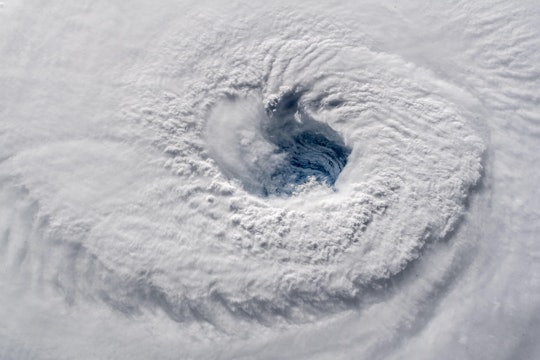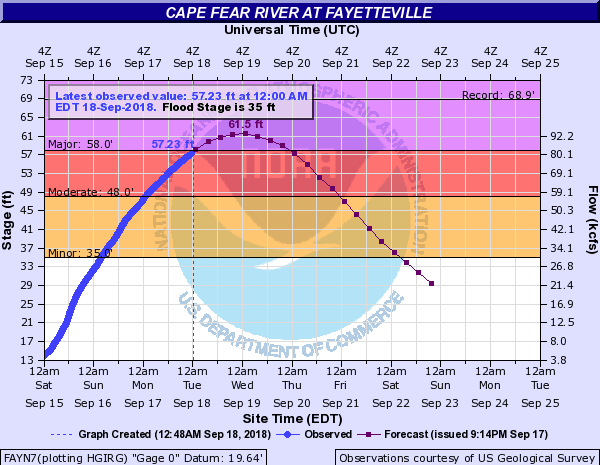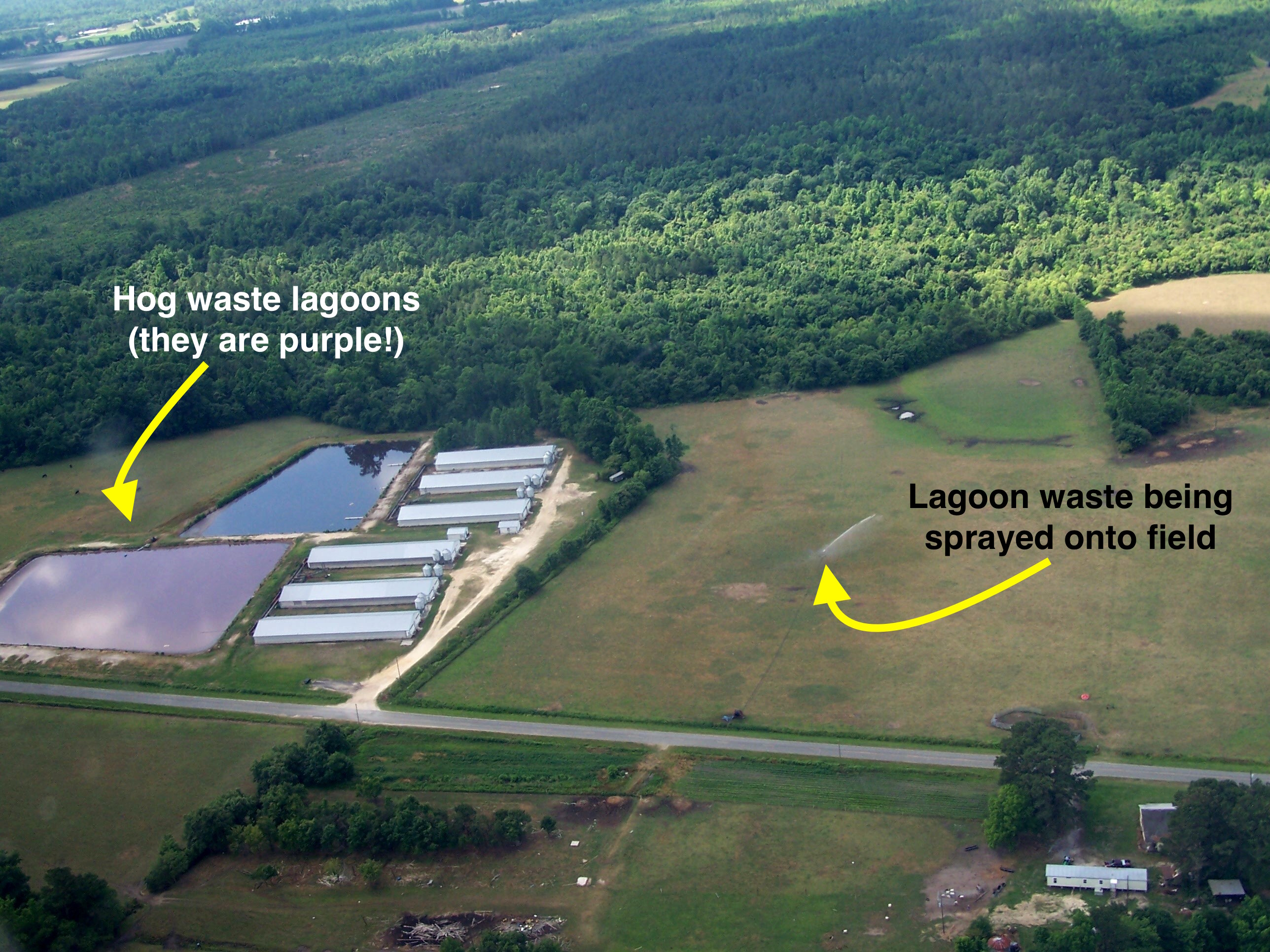
A. Gerst, ESA/NASA
After Hurricane Florence, North Carolina's water quality will go down the toilet
Floodwaters contaminated with coal ash, human sewage, and animal waste throw the entire watershed out of balance
In the early morning of Wednesday, September 19, 2018, the Cape Fear River in Fayetteville, North Carolina crested at 61.4 feet – which is about 40 to 50 feet above normal. These extra four stories of water have flooded thousands of acres surrounding the small city, briefly reclaiming some of its historic flood plain in what some are already declaring an 1,000 year flood event (although in reality, this is the second “1,000 year event” within three years).

The Cape Fear River at Fayetteville, NC crested as predicted on Wednesday, September 19th, submerging surrounding lands.
National Weather Service, Advanced Hydrologic Prediction Service/ NOAA
Hurricane Florence landed in Wrightsville Beach, NC as a Category 1 hurricane, downgraded from the fears it would arrive as category 4. Yet the downgrade is misleading. The Simpson-Safir scale used to create these categories only considers sustained wind speed, meaning despite the reduced winds, the storm came ashore with the same formidable amount of moisture. Turns out Florence is not a light packer; the storm dumped about 18 million gallons of rain over the region, depositing 30 to 35 inches of rain in some places. Winds and flooding have already caused at least 32 deaths and serious physical damage to homes and infrastructure.
In college, I worked as a water quality research technician in the Cape Fear River watershed. And while human health and welfare take precedence in this disaster, the Cape Fear river and estuary system is taking a beating too. Dr. Hans Paerl from the University of North Carolina Chapel Hill recently published a study that details just how remarkably hurricanes can impact river and estuary systems.
Paerl’s team used water quality data collected over 20 years within the Neuse River-Pamlico Sound system, directly to the north of the Cape Fear river. They found hurricanes can add major loads of organic carbon, as well as nutrients like nitrogen and phosphorus. These additives may change the ability of the downstream system to store carbon dioxide, an important greenhouse gas. Similar results have been seen in the Cape Fear system using data from 1989 - 2005. These results impact our wallets and stomachs, as hurricane-altered water quality was also found to change the makeup and mass of primary producers—the bottom of the food web—that we rely on for fish and shellfish.
The nutrients and organic carbon discussed in Paerl’s study come from both natural and human sources. As the river jumps its banks during a storm, it fans out onto its floodplain, picking up dead plant material and nutrients from swamplands and bottom-land forest. But human contamination can make a big difference too: large rain events can overwhelm municipal sewage systems and pump stations, pushing an overflow of human sewage into floodwaters. In the Cape Fear watershed, there are also numerous coal ash disposal pits, where ash left over from coal-fired power plants is stored. These pits can be compromised by flood conditions, adding heavy metals and rare earth minerals to the flood cocktail. Current and historical industrial sites might also contribute problematic pollutants if flooded.
And as luck (or a lack of it) would have it, the Cape Fear watershed contains a high density of concentrated animal feeding operations (CAFOs). The watershed produces an estimated 10 million pigs, 16 million turkeys, and 300 million chickens, along with tremendous amounts of 💩, chock full of nutrients like nitrogen and phosphorus along with fecal bacteria.
Dr. Michael Mallin at the University of North Carolina Wilmington has been studying the Cape Fear watershed for decades. Mallin has identified a host of negative water quality repercussions related to CAFOs even in normal conditions—often to the chagrin or denial of the hog industry. Animal waste is often applied to fields as dry litter or pumped into big pools, called lagoons, intended to facilitate decomposition before being sprayed onto fields. This waste management system is hardly effective in dry periods, as waste from lagoons has been shown to contaminate groundwater and adjacent surface water in streams, causing health issues in adjacent communities.

Hog farms store waste in large pools, and then spray it onto fields of feed crops.
Dr. Michael A. Mallin
“Dumping raw swine waste into open pits and spraying it out on fields is not an effective way to treat nutrient and pathogen-rich waste, it is only the cheapest. Since hundreds of such waste lagoons are on the low-lying Coastal Plain, they are pollution time bombs waiting to go off in this hurricane-prone region,” says Mallin.
Extreme flood events like Florence can cause lagoons to overflow or be swallowed by the swollen river, causing mass contamination of floodwaters with nutrient and bacteria-ridden waste. In 2016's Hurricane Matthew, when the river crested at 52 feet, as many as 14 lagoons were breached.
It’s now clear communities and CAFOs took a serious beating during Florence. State and independent sources suggest 3 hog lagoons were breached, 2 were structurally damaged, 21 were inundated by floodwaters, and 17 lagoons overflowed, along with municipal sewage spills, at least one coal ash pit breach, and thousands of drowned animals thanks to Hurricane Florence. Despite the degree of damage to hog lagoons, these cesspools don’t even need to be directly breached to contribute their noxious waste to floodwaters. Hog farmers prepare for large rain events by pumping out their lagoons, spraying the material on fields. When the rains arrive, these unabsorbed nutrients and organic material run off into adjacent waterways anyway.

The Cape Fear river and its contributing streams are a nature enthusiast’s wonderland, comprised of unique habitats like hardwood bottomlands, rare freshwater tidal wetlands, and saltwater marsh.
Mary Grace Lemon
Even with the huge volume of rain seen during Florence, the solution to all this pollution isn’t dilution, as the aftermath of previous hurricanes like Matthew, Floyd, or Fran in 1996, demonstrated. The overabundance of nutrients, coupled with loads of degradable wastes, leads to plummeting oxygen levels in the water column. Bacteria simply use up too much of the oxygen dissolved in the water trying to decompose storm-sourced materials. The Cape Fear system is a blackwater system with naturally low dissolved oxygen levels, so storm-induced oxygen depletion can readily lead to dramatic kills of fish and bottom-dwelling aquatic creatures, as seen in the Northeast Cape Fear in 1996.
It's not just the river system that suffers either. Waste lagoons and human sewage contain high loads of disease-causing maladies, like E.coli bacteria and antibiotic resistance genes. By contaminating the water, these pollutants compromise drinking water sources and add an additional degree of risk to citizens fleeing floodwaters or to clean-up efforts in the aftermath of the storm.
Considering Atlantic hurricanes are projected to occur more frequently, move more slowly, and as result, carry more moisture, watersheds along the Eastern seaboard must start to think critically about their preparedness for 100 to 1,000 year floods. While Andy Curliss, CEO of the North Carolina Pork Council, contends that lagoons across the state can deal with 25 inches of rain, even that may not be enough due to climate change; in the last two years, two hurricanes have dumped 20 to 35 inches of rain in locations across the state.
Florence shattered lives and infrastructure, requiring long-term recovery efforts across a wide swath of the Carolinas. And the long-term water quality and food web ramifications of Florence will only play out in the coming weeks and months.
If you would like to aid relief efforts, check out this list of opportunities compiled by the New York Times, along with efforts endorsed via Michael Jordan’s relief efforts.


I think at this point there’s maybe half a dozen different coal ash sites either at risk of (or are already) spilling ash as a result of Florence, and it’s going to be very challenging to determine exactly how much ash has actually spilled because the flooding covered so much ground.
Coal ash tends to be fairly light (about half as dense as sand), so it’ll be transported in the floodwaters before settling. When it settles, though, things can get dicey: when sediment gets buried, those sediment layers become oxygen deprived. Oxygen-poor environments result in heavy metals being more mobile and more bioavailable.
What frustrates me is that we are finally ALMOST handling this problem: power companies are starting to transport the ash out of unsafe facilities and move them into lined, covered landfills. One of the compromised coal ash sites, Sutton, is no longer an active coal plant, and Duke Energy started relocating the ash in 2015.
At that site, the ash is covered by a thick earthen cap, both of which were inundated in the flooding, resulting in the loss of some 2,000 cubic yards of ash (almost 1 Olympic sized swimming pool).
So far, reports from Duke Energy indicate that there are no issues with water quality as a result… but as a spokesperson said, “We’ll learn more as flood water recedes.”
It really makes you think, too, about renewables: solar and wind don’t have these associated problems and can get back online so much faster – within days – after extreme weather events, compared to traditional fossil fuel and nuclear power plants.